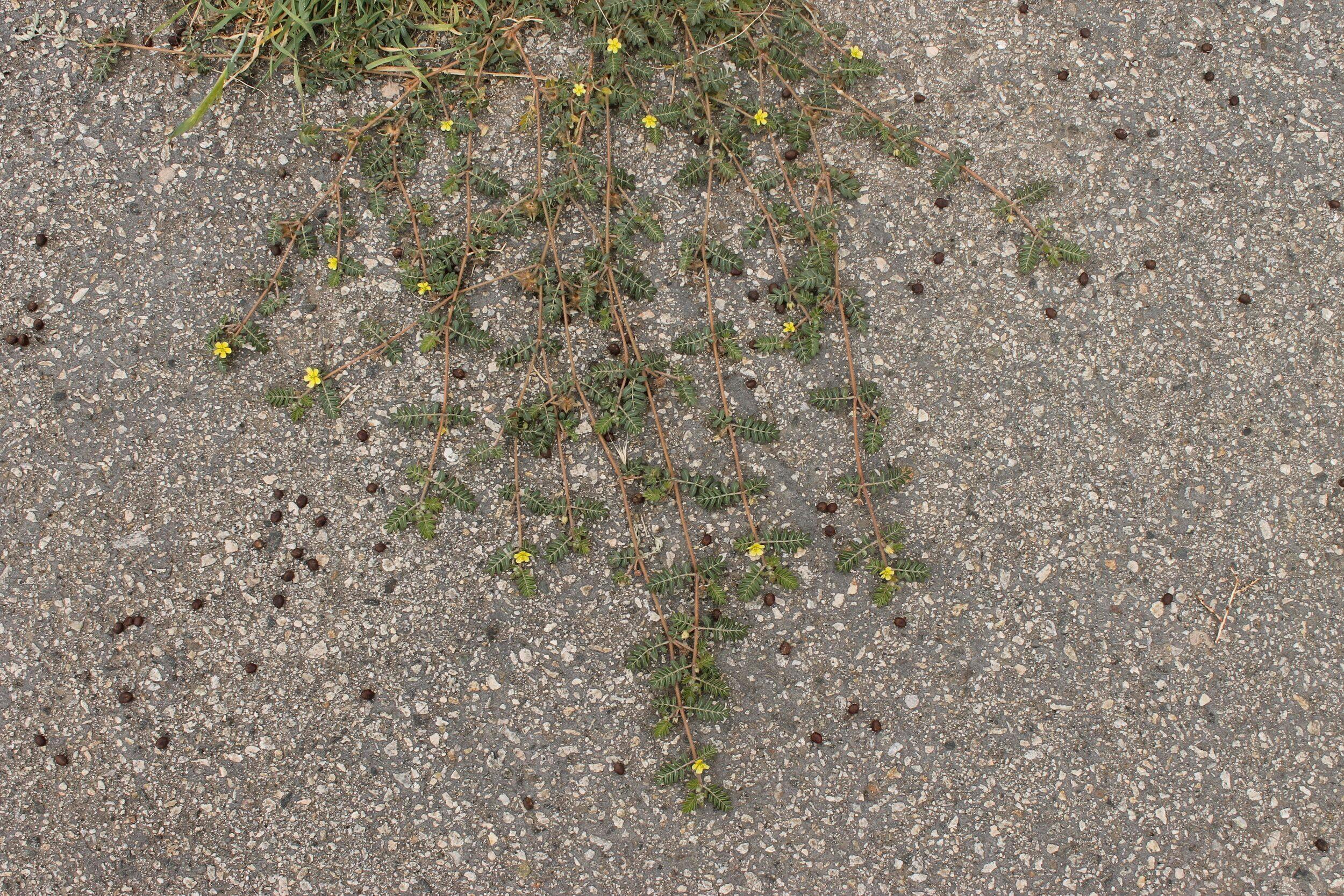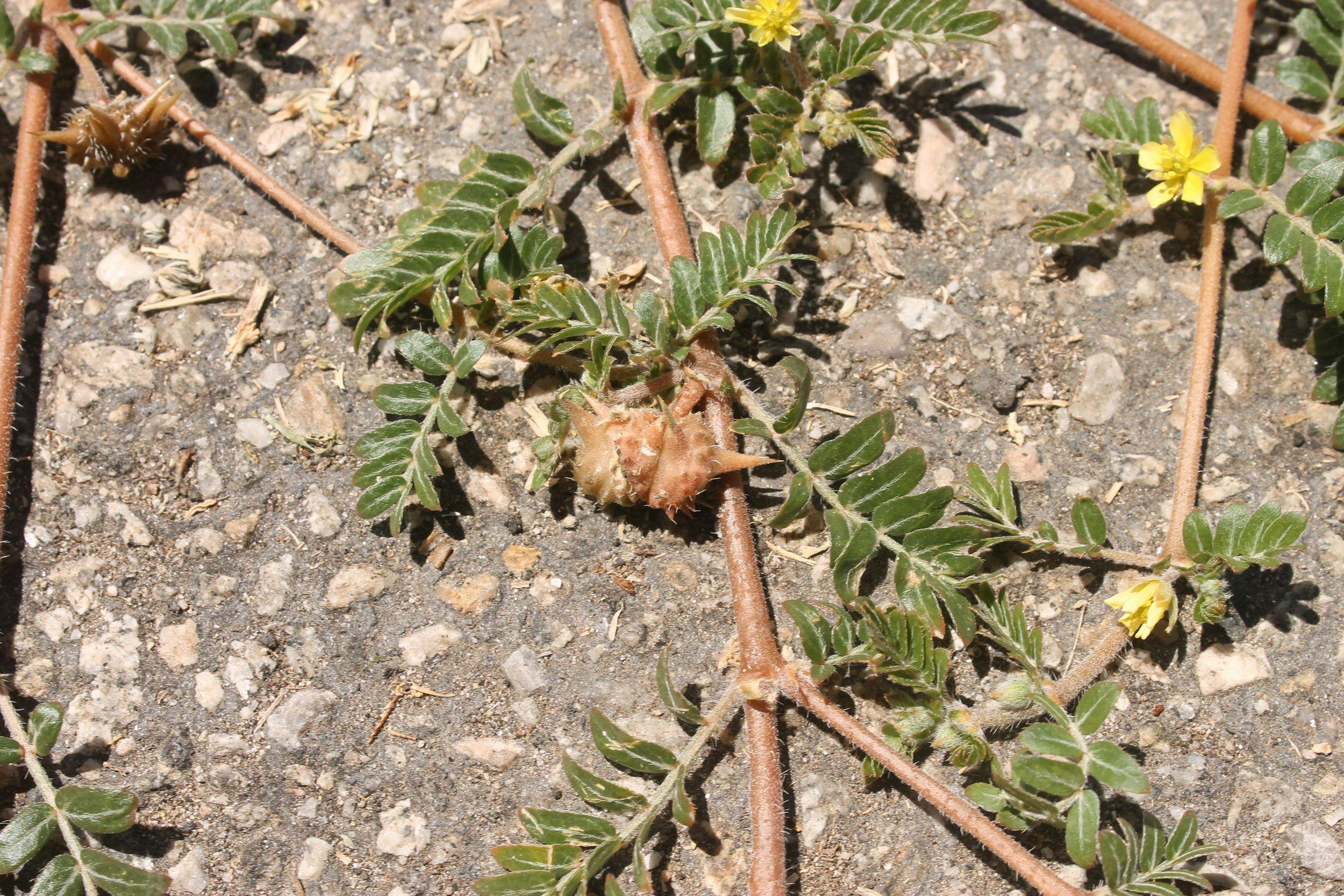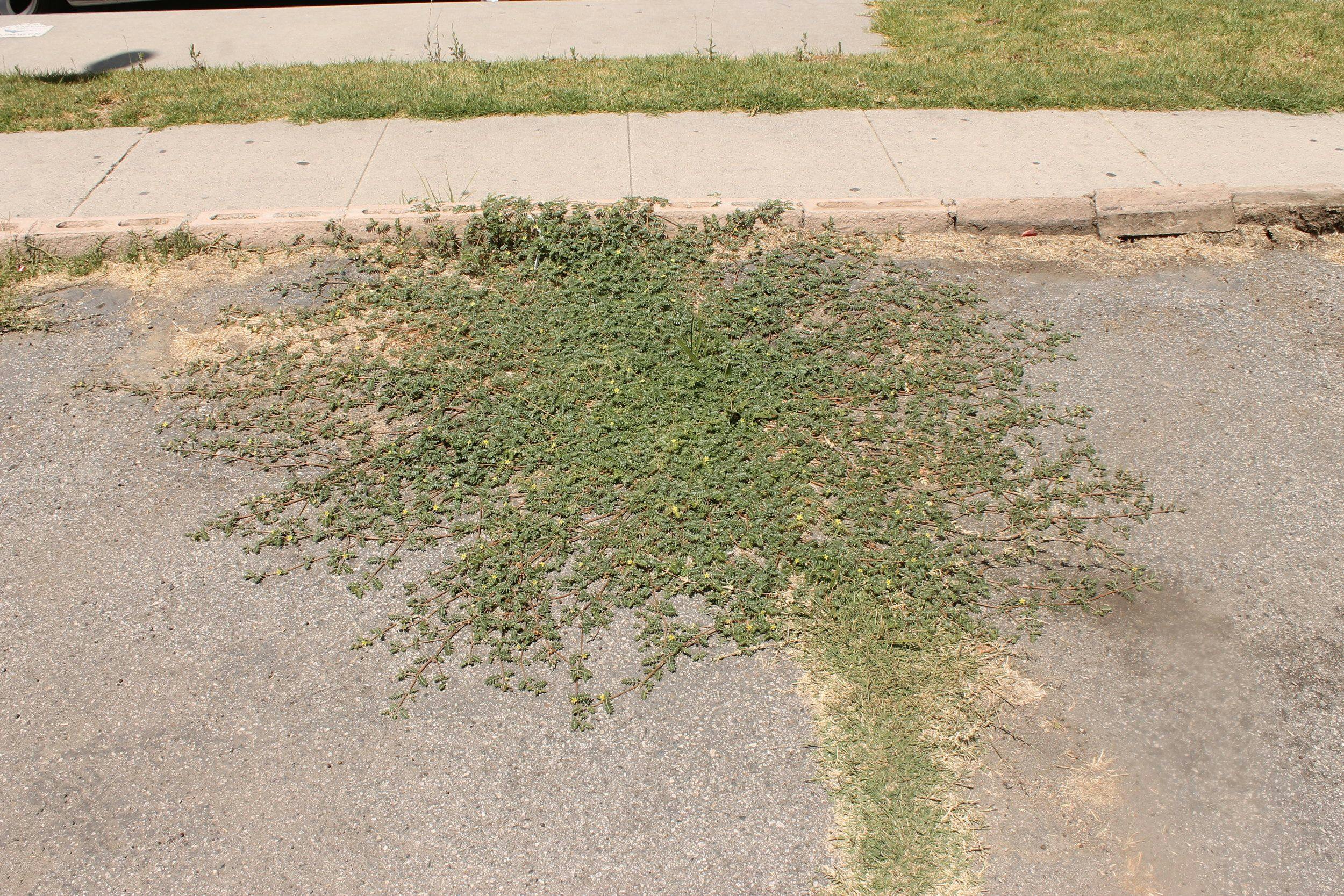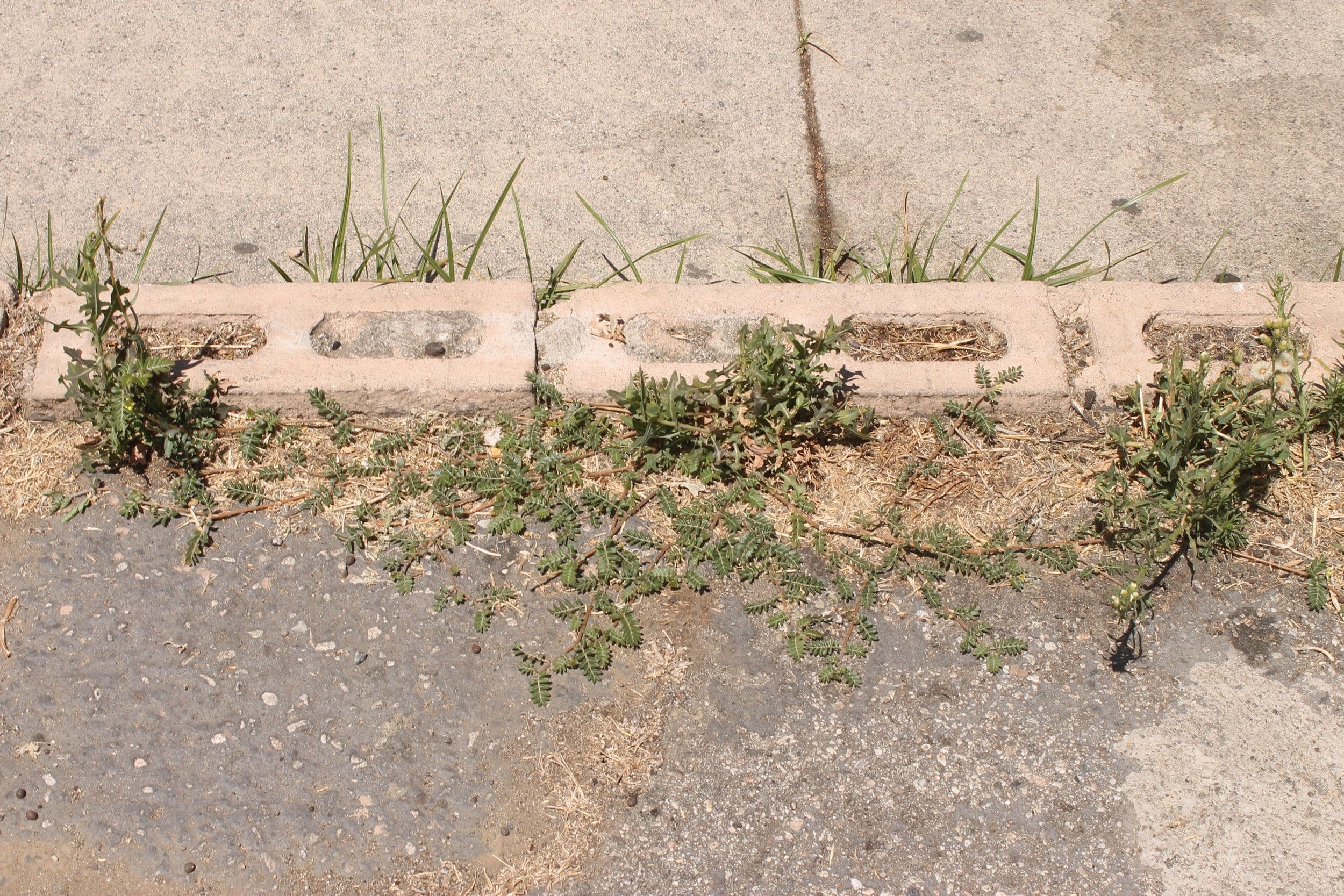The plants that we label as weeds often have complicated and ambiguous relationships with humans. They plague our agricultural fields, tarnish our perfectly manicured gardens and invade our coveted wildlands. But at the same time, many of these plants have long histories of use as foods, medicines and other products. Goat's head, a creeping plant which colonizes the concrete expanses of Los Angeles, is a prime example. Its long history of use as a medicine and supplement is contrasted by its aggressive spread and irritating, spiny fruits. The success of 'weeds' like Goat's head can be attributed to their ability to exploit new niches and ecologies of the anthropogenic landscape. In the case of Goat's head, a species adapted to hot, dry disturbed landscapes, the arrival of new transportation technology in the early 1900s created opportunities for the distribution of its seeds far and wide throughout the American west.
Goat's head is a prostrate, sprawling, annual species. Opposite, pinnately compound leaves grow on stems which originate at the plant's crown, and large specimens can grow to several feet in diameter. The stems and leaflets are covered in dense hairs, which under the right light give the plant a slightly off-green tinge. In Los Angeles, plants typically bloom during the summer, sending out yellow, five-petaled flowers which are approximately a quarter inch in diameter. These develop into fruits composed of five small, hard nutlets which are initially fused together, but split apart as the fruit dries. Each nutlet is adorned with two to four sharp spines. These spines give an alternative common name to this species, Puncture vine, which describes their ability to puncture anything that lands on them. The common name of Goat's head also references the nutlets, whose spines (with some imagination) resemble the horns of a goat. Goat's head is considered to be native to Southern Europe, although it is a weedy, disturbance-associated species even there. Judging by it's use as a traditional medicine in Asian cultures, it likely colonized Southern Asia well before it crossed the ocean to establish itself in North America and other parts of the world. Today it is considered a noxious weed in many places, including California.

In Los Angeles, Goat's head can be found in vacant lots, decaying asphalt parking lots and other highly disturbed locations. Its creeping habit can produce interesting contrasts between plant life and the urban environment, as the plants germinate in cracks in the pavement and send green foliage creeping above these normally inhospitable surfaces. Those who wander the streets of LA barefoot may be in store for a painful encounter with this plant. The city's bike riders also have to contend with the spiny fruits. Throughout the range of Goat's head, it is not uncommon for bike riders to share information on where plants are and what stage of development the fruits are in in order to avoid a popped tire. Photos of nutlets lodged into bike tires show the original distribution strategy of the species, in which the spiny nutlets lodge themselves into the fur of passing animals to spread their seeds to new territories. It appears that the rubber tires of bicycles have become a preferred megafaunal distribution vector of Goat's head in 2019.
Goat's head has a long association with humans, not only as a weedy and irritating colonizer of the places we live, but also as a medicinal supplement. Many different cultures make use of this plant, including prominent traditional medical systems such as Ayurveda, Chinese, Siddha, and Unani. As a folk medicine, it is used to treat an impressive variety of ailments, including urinary infections, eye trouble, headache, venereal diseases, vitiligo and flatulence. In most cases, the powderized fruits of the plant are the preferred method of delivery. The multicultural use of this plant as a medicine is well documented, as is the impressive array of medically important chemical compounds found within the plant. Western medical research has found some promising results in clinical trials, including the potential to lower blood sugar and cholesterol levels in diabetic women. Most studies suggest that more research is needed to evaluate the efficacy of these treatments.

The fact that this plant has adapted to dispersal by modern megafauna is complemented by the appetites of one of the most impressive groups of human megafaunal specimens, the body builders. It is highly prized in the bodybuilding community as a testosterone booster. Advertising copy for daily supplements of powderized extract state that it will allow users to "achieve a lean and muscled body fast" and as a male sexual enhancer will "lift your T-levels, mood and boost performance". The advertisers go on to claim (incorrectly, considering its long history of use in many cultures) that it was "originally used by Russian powerlifters and today is still known as the 'original powerlifters secret.'" Though a recent systematic review found no evidence to support the marketing claims, it remains popular. With a daily dose of these supplements costing over twenty dollars a month, it makes one wonder if the bodybuilders of LA know that it grows wild all over their city.
In contrast to the plants that were previously profiled in this series, which were well established by the mid nineteenth century, Goat's head appears in the public record of California rather late. The earliest newspaper articles mentioning it don't occur until 1920. Pressed herbarium specimens collected in 1902 in Santa Monica confirm that it was in LA before then. These are the earliest documented occurrences of the plant in California. There is no clear consensus about how the plant arrived in the state. The first scientific article documenting Goat's head in California dates back to 1903, where it was described as growing along a railroad back, likely introduced from Arizona. It became such a nuisance so quickly that the popular media also covered its origin, with a variety of explanations for how it arrived in Southern California. A 1921 article in the LA Times again suggested that the plant had arrived along railroad tracks, but from Northern California as opposed to Arizona. Other articles of the same decade claimed that it arrived clinging to the fleece of sheep (a human-assisted extension of its original distribution method), or with ballast in ships from the Mediterranean.

Regardless of its origin, once the first articles mentioning Goat's head in California appeared in the 1920s, they were frequent. This had to do with the newest mechanized megafauna on the landscape, the automobile. Motorists were finding their tires popped by the spiny fruits, and in the process were spreading the seeds with speeds and efficiency never before possible. News of this novel plague of the arid west travelled as far as the east coast. In all of these articles, one thing is exceedingly clear. Californians did not want this plant in their state. Article after article describe the negative qualities of this plant and the various efforts to keep it from spreading. Farmers, railroad men, highwaymen, and horticulture commissioners met to find a solution to the problem. City council-approved eradication plans, boycotting of contaminated hay, and legislation aimed solely at removing this plant were all on the table. The goal was to extirpate the plant from California in any way possible.
Some of these early eradication tactics, such as spraying plants with crude oil, seem woefully misguided by today's standards of environmental safety, and in spite of headlines such as 'Puncture Vine War Effective', the war continued throughout the 20th century and continues to this day. The most recent incarnation of the Puncture Vine War involves the introduction of weevils from the Mediterranean which feed on the plants, and could presumably control populations in other parts of the world. An article giving an overview of this process mentions that though a number of weevils feed on this plant in its native range, the final two candidates for introduction were a relatively large and a small weevil. In the end, scientists chose "the lesser of two weevils." While farmers still must contend with the damage this plant causes to the mouths of livestock who ingest it, in the city it has lost the immediacy of concern of the days when any driver in the Southland could expect a popped tire with a spiny nutlet as the culprit. With thicker, puncture-proof vehicle tires, the problem of urban Puncture vines is now largely the concern of dogs, bike riders, and barefoot walkers.

Despite all of the efforts that Californians took to eradicate Goat's head from the state, it staunchly remains, and bodybuilders, herbalists, and practitioners of Ayurveda and Chinese medicine pay good money to consume it. Like so many weeds, its value is conflicted. Depending on who you ask, it is a noxious pest or a freely-growing, powerful medicine. But perhaps the most impressive attribute of this plant is its adaptation to a world much different from the one it first evolved in. As a successful colonizer of the anthropogenic ecosystem of Los Angeles, it is has found a way to spread freely throughout the land, hitching a ride on the biological and mechanized megafauna of our modern world.

